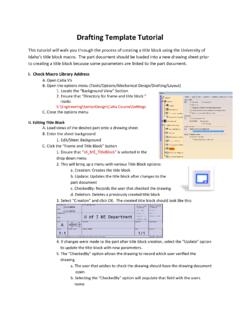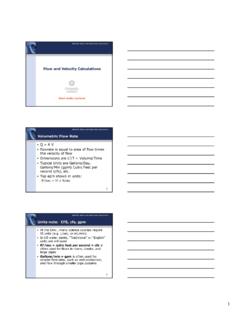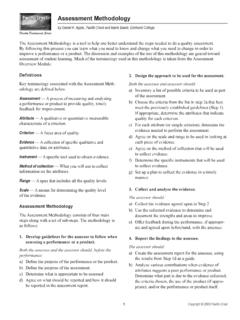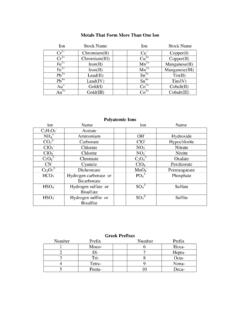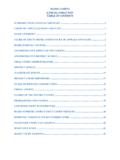Transcription of Pandas DataFrame Notes - University of Idaho
1 Version 2 May 2015 - [Draft Mark Graph mark dot the dot graph at gmail dot com @Mark_Graph on twitter] 1 Cheat Sheet: The Pandas DataFrame Object Preliminaries Start by importing these Python modules import numpy as np import as plt import Pandas as pd from Pandas import DataFrame , Series Note: these are the recommended import aliases The conceptual model DataFrame object: The Pandas DataFrame is a two-dimensional table of data with column and row indexes. The columns are made up of Pandas Series objects. Series object: an ordered, one-dimensional array of data with an index. All the data in a Series is of the same data type. Series arithmetic is vectorised after first aligning the Series index for each of the operands. s1 = Series(range(0,4)) # -> 0, 1, 2, 3 s2 = Series(range(1,5)) # -> 1, 2, 3, 4 s3 = s1 + s2 # -> 1, 3, 5, 7 s4 = Series(['a','b'])*3 # -> 'aaa','bbb' The index object: The Pandas Index provides the axis labels for the Series and DataFrame objects.
2 It can only contain hashable objects. A Pandas Series has one Index; and a DataFrame has two Indexes. # --- get Index from Series and DataFrame idx = idx = # the column index idx = # the row index # --- some Index attributes b = b = b = i = # multi-level indexes # --- some Index methods a = () # get as numpy array l = () # get as a python list idx = (dtype)# change data type b = (o) # check for equality idx = (o) # union of two indexes i = () # number unique labels label = () # minimum label label = () # maximum label Get your data into a DataFrame Load a DataFrame from a CSV file df = (' ')# often works df = ( , header=0, index_col=0, quotechar= ,sep= : , na_values = [ na , - , . , ]) Note: refer to Pandas docs for all arguments From inline CSV text to a DataFrame from StringIO import StringIO # #from io import StringIO # python 3 data = """, Animal, Cuteness, Desirable row-1, dog, , True row-2, bat, , False""" df = (StringIO(data), header=0, index_col=0, skipinitialspace=True) Note: skipinitialspace=True allows a pretty layout Load DataFrames from a Microsoft Excel file # Each Excel sheet in a Python dictionary workbook = (' ') dictionary = {} for sheet_name in : df = (sheet_name) dictionary[sheet_name] = df Note: the parse() method takes many arguments like read_csv() above.
3 Refer to the Pandas documentation. Load a DataFrame from a MySQL database import pymysql from sqlalchemy import create_engine engine = create_engine('mysql+pymysql://' +'USER:PASSWORD@localhost/DATABASE') df = ('table', engine) Data in Series then combine into a DataFrame # Example 1 .. s1 = Series(range(6)) s2 = s1 * s1 = + 2# misalign indexes df = ([s1, s2], axis=1) # Example 2 .. s3 = Series({'Tom':1, 'Dick':4, 'Har':9}) s4 = Series({'Tom':3, 'Dick':2, 'Mar':5}) df = ({'A':s3, 'B':s4 }, axis=1) Note: 1st method has in integer column labels Note: 2nd method does not guarantee col order Note: index alignment on DataFrame creation Get a DataFrame from data in a Python dictionary # default --- assume data is in columns df = DataFrame ({ 'col0' : [ , , , ], 'col1' : [100, 200, 300, 400] }) Column index ( ) Series of data Series of data Series of data Series of data Series of data Series of data Series of data Row index ( ) Version 2 May 2015 - [Draft Mark Graph mark dot the dot graph at gmail dot com @Mark_Graph on twitter] 2 Get a DataFrame from data in a Python dictionary # --- use helper method for data in rows df = ({ # data by row 'row0' : {'col0':0, 'col1':'A'}, 'row1'.)}
4 {'col0':1, 'col1':'B'} }, orient='index') df = ({ # data by row 'row0' : [1, 1+1j, 'A'], 'row1' : [2, 2+2j, 'B'] }, orient='index') Create play/fake data (useful for testing) # --- simple df = DataFrame ( (50,5)) # --- with a time-stamp row index: df = DataFrame ( (500,5)) = ('1/1/2006', periods=len(df), freq='M') # --- with alphabetic row and col indexes import string import random r = 52 # note: min r is 1; max r is 52 c = 5 df = DataFrame ( (r, c), columns = ['col'+str(i) for i in range(c)], index = list(( + )[0:r])) df['group'] = list( ''.join( ('abcd') for _ in range(r)) ) Saving a DataFrame Saving a DataFrame to a CSV file (' ', encoding='utf-8') Saving DataFrames to an Excel Workbook from Pandas import ExcelWriter writer = ExcelWriter(' ') (writer,'Sheet1') (writer,'Sheet2') () Saving a DataFrame to MySQL import pymysql from sqlalchemy import create_engine e = create_engine('mysql+pymysql://' + 'USER:PASSWORD@localhost/DATABASE') ('TABLE',e, if_exists='replace') Note: if_exists !
5 'fail', 'replace', 'append' Saving a DataFrame to a Python dictionary dictionary = () Saving a DataFrame to a Python string string = () Note: sometimes may be useful for debugging Working with the whole DataFrame Peek at the DataFrame contents () # index & data types n = 4 dfh = (n) # get first n rows dft = (n) # get last n rows dfs = () # summary stats cols top_left_corner_df = [:5, :5] DataFrame non-indexing attributes dfT = # transpose rows and cols l = # list row and col indexes (r, c) = # from above s = # Series column data types b = # True for empty DataFrame i = # number of axes (2) t = # (row-count, column-count) (r, c) = # from above i = # row-count * column-count a = # get a numpy array for df DataFrame utility methods dfc = () # copy a DataFrame dfr = () # rank each col (default) dfs = () # sort each col (default) dfc = (dtype) # type conversion DataFrame iteration methods ()# (col-index, Series) pairs () # (row-index, Series) pairs # example.
6 Iterating over columns for (name, series) in (): print('Col name: ' + str(name)) print('First value: ' + str( [0]) + '\n') Maths on the whole DataFrame (not a complete list) df = () # absolute values df = (o) # add df, Series or value s = () # non NA/null values df = () # (cols default axis) df = () # (cols default axis) df = () # (cols default axis) df = () # (cols default axis) df = () # 1st diff (col def axis) df = (o) # div by df, Series, value df = (o) # matrix dot product s = () # max of axis (col def) s = () # mean (col default axis) s = ()# median (col default) s = () # min of axis (col def) df = (o) # mul by df Series val s = () # sum axis (cols default) Note: The methods that return a series default to working on columns. DataFrame filter/select rows or cols on label info df = (items=['a', 'b']) # by col df = (items=[5], axis=0) #by row df = (like='x') # keep x in col df = (regex='x') # regex in col df = (crit=(lambda x:not x%5))#r Note: select takes a Boolean function, for cols: axis=1 Note: filter defaults to cols.
7 Select defaults to rows Version 2 May 2015 - [Draft Mark Graph mark dot the dot graph at gmail dot com @Mark_Graph on twitter] 3 Working with Columns A DataFrame column is a Pandas Series object Get column index and labels idx = # get col index label = [0] # 1st col label lst = () # get as a list Change column labels (columns={'old':'new'}, inplace=True) df = (columns={'a':1,'b':'x'}) Selecting columns s = df['colName'] # select col to Series df = df[['colName']] # select col to df df = df[['a','b']] # select 2 or more df = df[['c','a','b']]# change order s = df[ [0]] # select by number df = df[ [[0, 3, 4]] # by number s = ('c') # get col & drop from df Selecting columns with Python attributes s = # same as s = df['a'] # cannot create new columns by attribute = / df['new_col'] = / Trap: column names must be valid identifiers. Adding new columns to a DataFrame df['new_col'] = range(len(df)) df['new_col'] = ( ,len(df)) df['random'] = (len(df)) df['index_as_col'] = df1[['b','c']] = df2[['e','f']] df3 = (other=df2) Trap: When adding an indexed Pandas object as a new column, only items from the new series that have a corresponding index in the DataFrame will be added.]
8 The receiving DataFrame is not extended to accommodate the new series. To merge, see below. Trap: when adding a python list or numpy array, the column will be added by integer position. Swap column contents change column order df[['B', 'A']] = df[['A', 'B']] Dropping columns (mostly by label) df = ('col1', axis=1) ('col1', axis=1, inplace=True) df = (['col1','col2'], axis=1) s = ('col') # drops from frame del df['col'] # even classic python works ( [0], inplace=True) Vectorised arithmetic on columns df['proportion']=df['count']/df['total'] df['percent'] = df['proportion'] * Apply numpy mathematical functions to columns df['log_data'] = (df['col1']) df['rounded'] = (df['col2'], 2) Note: Many more mathematical functions Columns value set based on criteria df['b']=df['a'].where(df['a']>0,other=0) df['d']=df['a'].where( !=0,other= ) Note: where other can be a Series or a scalar Data type conversions s = df['col'].
9 Astype(str) # Series dtype na = df['col'].values # numpy array pl = df['col'].tolist() # python list Note: useful dtypes for Series conversion: int, float, str Trap: index lost in conversion from Series to array or list Common column-wide methods/attributes value = df['col'].dtype # type of data value = df['col'].size # col dimensions value = df['col'].count()# non-NA count value = df['col'].sum() value = df['col'].prod() value = df['col'].min() value = df['col'].max() value = df['col'].mean() value = df['col'].median() value = df['col'].cov(df['col2']) s = df['col'].describe() s = df['col'].value_counts() Find index label for min/max values in column label = df['col1'].idxmin() label = df['col1'].idxmax() Common column element-wise methods s = df['col'].isnull() s = df['col'].notnull() # not isnull() s = df['col'].astype(float) s = df['col'].round(decimals=0) s = df['col'].diff(periods=1) s = df['col'].
10 Shift(periods=1) s = df['col'].to_datetime() s = df['col'].fillna(0) # replace NaN w 0 s = df['col'].cumsum() s = df['col'].cumprod() s = df['col'].pct_change(periods=4) s = df['col'].rolling_sum(periods=4, window=4) Note: also rolling_min(), rolling_max(), and many more. Append a column of row sums to a DataFrame df['Total'] = (axis=1) Note: also means, mins, maxs, etc. Multiply every column in DataFrame by Series df = (s, axis=0) # on matched rows Note: also add, sub, div, etc. Selecting columns with .loc, .iloc and .ix df = [:, 'col1':'col2'] # inclusive df = [:, 0:2] # exclusive Get the integer position of a column index label j = ('col_name') Test if column index values are unique/monotonic if : pass # .. b = b = Version 2 May 2015 - [Draft Mark Graph mark dot the dot graph at gmail dot com @Mark_Graph on twitter] 4 Working with rows Get the row index and labels idx = # get row index label = [0] # 1st row label lst = () # get as a list Change the (row) index = idx # new ad hoc index = range(len(df)) # set with list df = () # replace old w new # note: old index stored as a col in df df = (index=range(len(df))) df = (keys=['r1','r2','etc']) (index={'old':'new'}, inplace=True) Adding rows df = (more_rows_in_df) Hint: convert to a DataFrame and then append.
